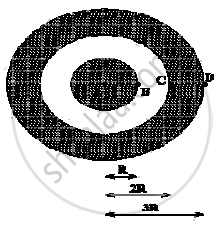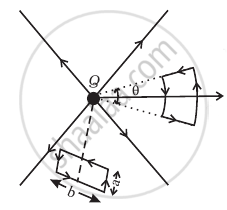Advertisements
Advertisements
Question
Fill in the blank.
A point charge is placed at the centre of a hollow conducting sphere of internal radius 'r' and outer radius '2r'. The ratio of the surface charge density of the inner surface to that of the outer surface will be_________.
Solution
Let the point charge be q.
by gauss's law, the charge on the inner surface will be - q
Surface charge density of the inner surface `sigma_i = - q/(4pir^2)`
by charge conservation, on the hollow sphere, the outer surface will have charge q
Surface charge density of the inner surface `sigma_o = q/(4pi(2r)^2) = q/(16pir^2)`
ratio = `sigma_i/sigma_o = (-q/(4pir^2))/(q/(16pir^2)) = -4/1`
APPEARS IN
RELATED QUESTIONS
A spherical conductor of radius 12 cm has a charge of 1.6 × 10−7 C distributed uniformly on its surface. What is the electric field
- inside the sphere
- just outside the sphere
- at a point 18 cm from the centre of the sphere?
A 4 µF capacitor is charged by a 200 V supply. It is then disconnected from the supply and is connected to another uncharged 2 µF capacitors. How much electrostatic energy of the first capacitor is lost in the form of heat and electromagnetic radiation?
Define electrostatic potential at a point. Write its S.I. unit. Three-point charges q1, q2 and q3 are kept respectively at points A, B, and C as shown in the figure, Derive the expression for the electrostatic potential energy of the system.

Electric-field magnitude 'E' at points inside and outside a positively charged spherical conductor having charge Q and a radius R are ______.
Which of the following statement is true?
Which of the following statements is false for a perfect conductor?
A solid spherical conductor has charge +Q and radius R. It is surrounded by a solid spherical shell with charge -Q, inner radius 2R, and outer radius 3R. Which of the following statements is true?

A test charge q is made to move in the electric field of a point charge Q along two different closed paths (Figure). First path has sections along and perpendicular to lines of electric field. Second path is a rectangular loop of the same area as the first loop. How does the work done compare in the two cases?

Consider a finite insulated, uncharged conductor placed near a finite positively charged conductor. The uncharged body must have a potential:
